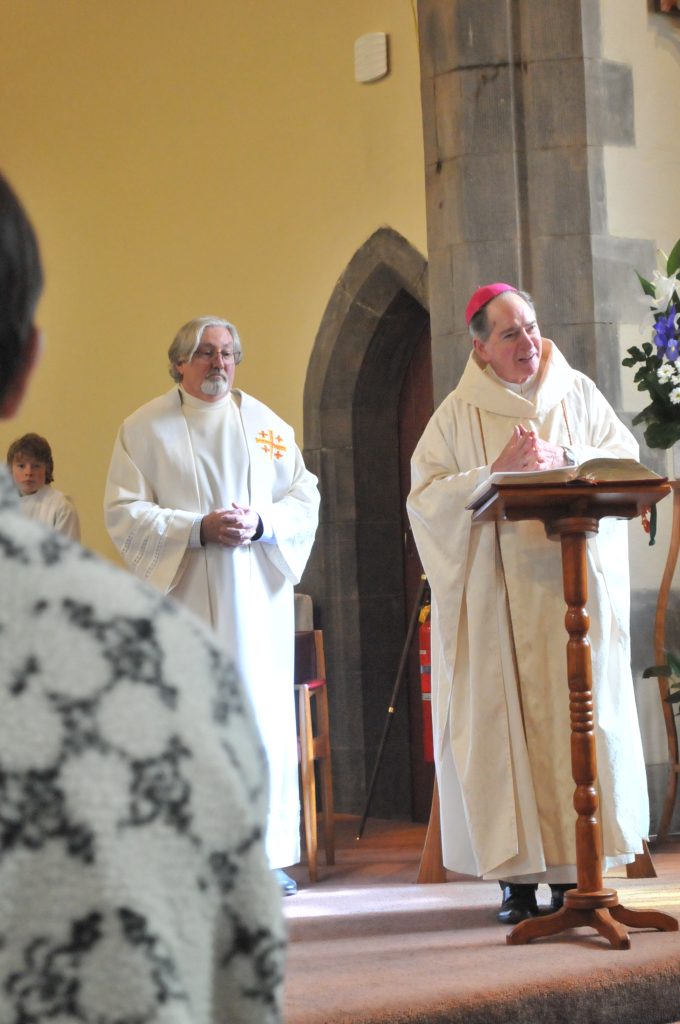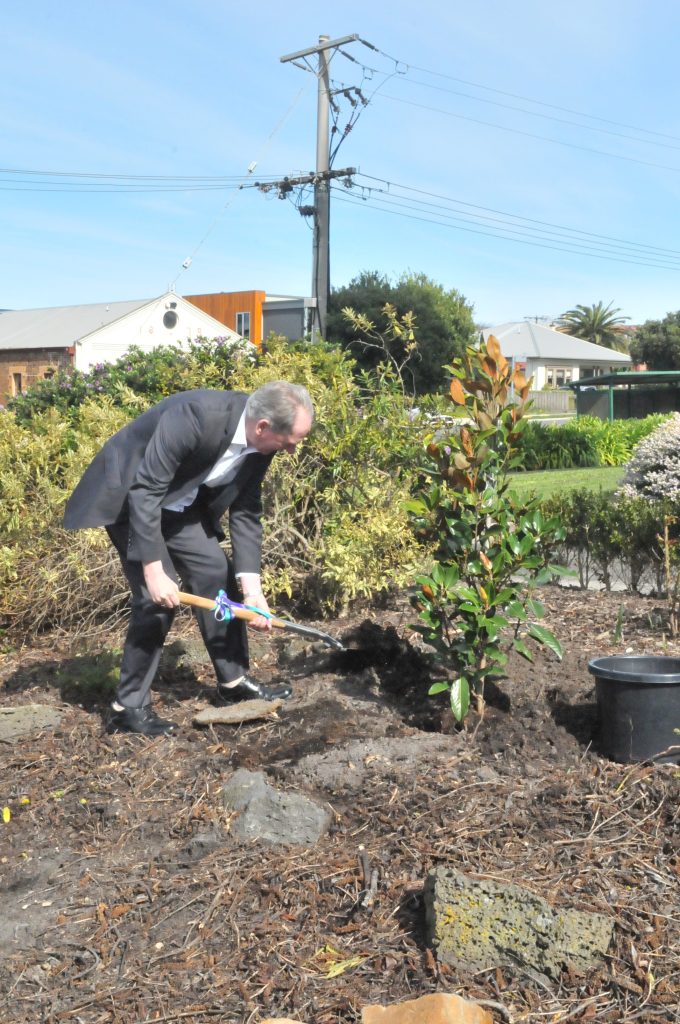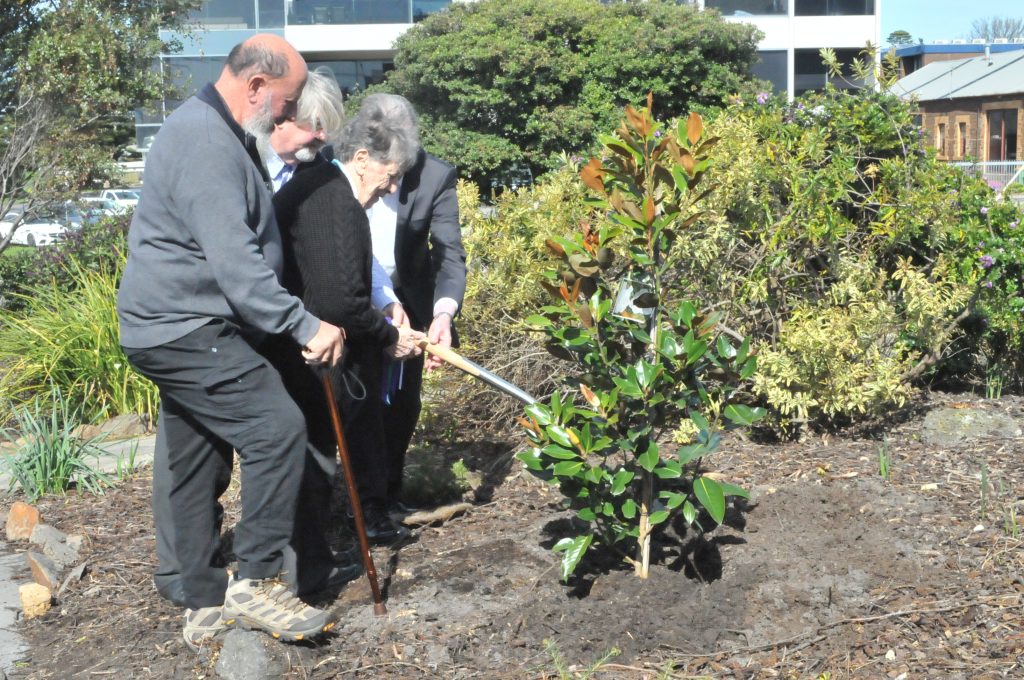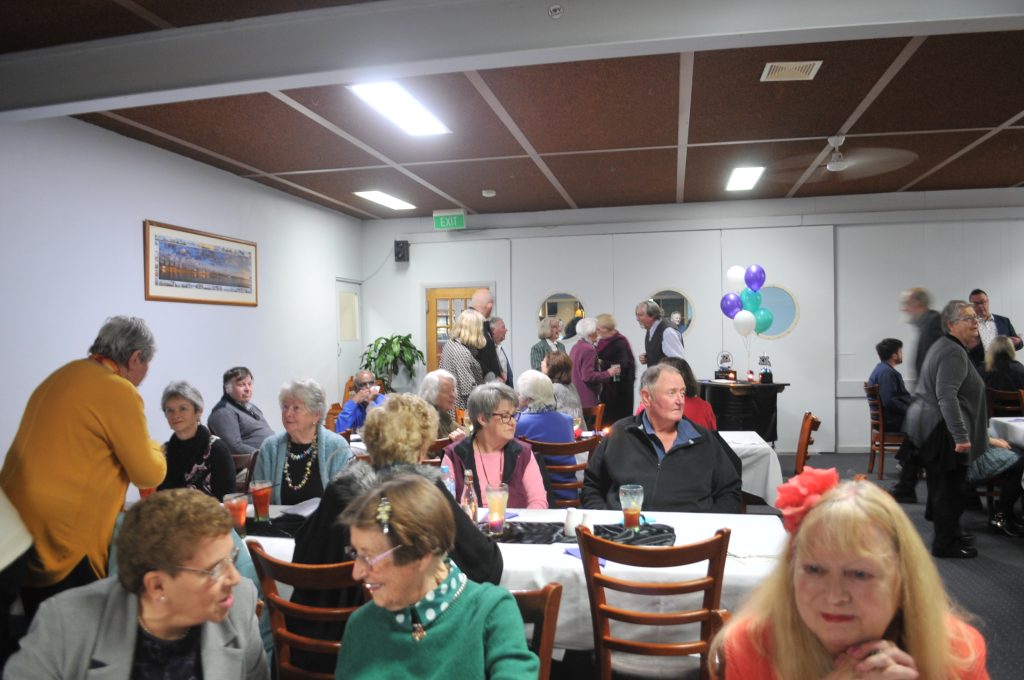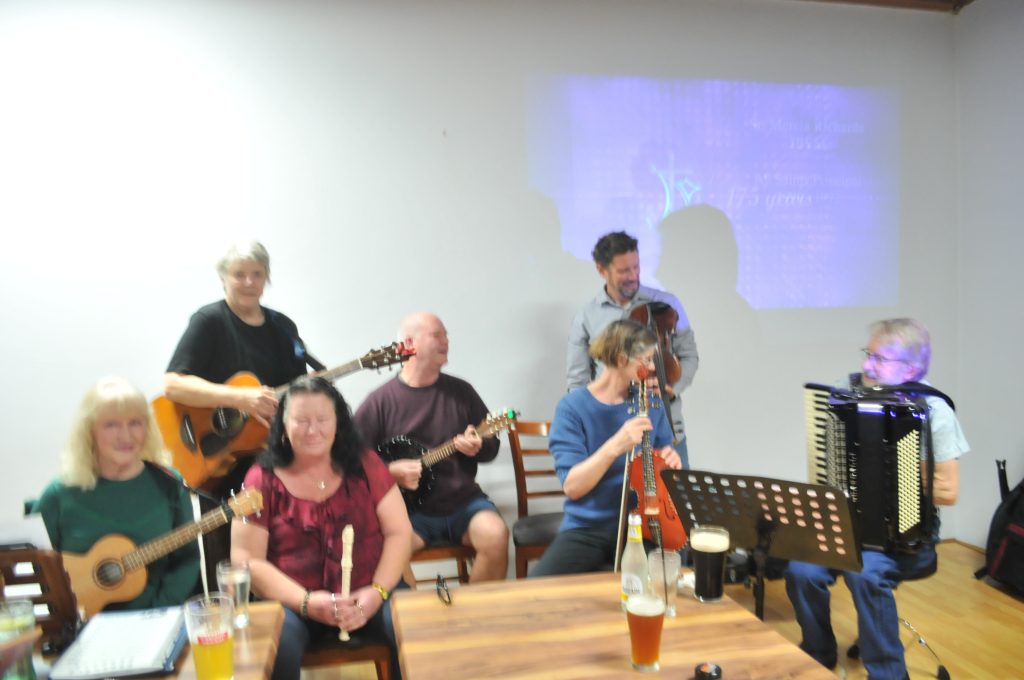Portland, founded by Edward Henty in 1834, is the oldest European settlement in this part of what was the Port Phillip District of the Colony of New South Wales. The Colony of Victoria was not proclaimed until 1850. Early records do not contain any recognition of Gunditjmara country and its peoples as a dynamic indigenous region.
The census of 1841 showed a Catholic population of about 203 souls amongst an estimated 800 people in the wider region. The establishment of Church communities (and their buildings) at this time was seen to be a civilising influence on the settlement and as such the whole population would often subscribe to the erection of individual Churches.
The establishment of Portland Catholic Parish followed the 1844 visit of John Bede Polding OSB (Archbishop of Sydney) to Melbourne, Geelong and thence to Portland, in response to the pleas of the Catholics of Portland town for a permanent Priest to administer pastoral care in the region. It was described in the “Portland Guardian” that the “public services” of the archbishop, “were well attended, Protestants, forming as large a proportion of the congregation as members of the Catholic Church.”
In 1847 Archbishop Polding formally proclaimed the Parish of All Saints Portland. As well as can be established, All Saints Portland was the third parish erected in the District of Port Phillip (after St Francis, Melbourne & St Mary of the Angels, Geelong). All Saints Parish has the second oldest Catholic School in the State. All Saints Parish is then the oldest Parish and school in what has become the Diocese of Ballarat. In early 1847, James Alipius Goold OSA had been named as the First Bishop of the Diocese of Port Phillip, but did not arrive in Australia for his consecration in Sydney until 1848.
The Rev Fr John Kavanagh arrived by ship in Portland on September 19, 1847, (having been attached to St Francis Church Melbourne) to take up his pastorate; signing himself as “Minister of Portland & Port Fairy”. This pioneer Priest ranged far and wide in his duties as Pastor to the Catholics of the region. Between his arrival and his departure to another appointment in early 1849. his journeys on horseback, around the region included visits to (what became) Hamilton, Dunkeld, Heywood, Mt Gambier, Wannon Falls, Penshurst, Coleraine and Harrow.
Fr Kavanagh set about the building of the first Catholic Chapel, on land set aside by the Colonial Secretary’s Office (based in Sydney) in 1846. This chapel was always envisaged to be a Church/School building and served the community as a Church until 1862 and as a school building until its demolition in 1978. From 1847 to the present day, All Saints has been served by 30 officially appointed Parish Priests.
It is important to remember that the impetus for the establishment of our parish was the insistence and determination of local Catholics. It is notable that Catholic Education of the children and youth of the parish resided in the hands of dedicated lay Catholics from 1849 until 1885, until the arrival (in December 1884) of the sisters of the Institute of the Blessed Virgin Mary (Loreto Sisters).
All Saints Parish School is today served by a team of lay teachers who are dedicated to the Parish School as a principal mission in the life of the local church and wider community.
Over the weekend of the August 27 & 28, 2022, the Parish held numerous celebrations to mark this historic event.
- On Friday, August 26, a Mass and BBQ was held at the Parish School. Before Mass began, the students gave a presentation telling the community what they had learnt about the Parish and its life over 175 years.
- On Saturday, August 27, the Parish hosted a dinner at the Royal Hotel with Bishop Paul Bird CSsR in attendance, along with over 80 others. A local Celtic music group entertained the gathered group. Following dinner Mr Bernard Wallace, a prominent local historian, gave an address on life in Portland in 1847 and what that life was like for Catholics and the wider pioneer community.
- Sunday, August 28 saw the culmination of these celebrations with the Anniversary Mass, celebrated by Bishop Paul. After the Mass, a commemorative tree planting took place in the front garden of the Parish Church. Lunch was then served at Bayview College by all who could attend.
Complied by Rev Gregory AD Tait PP
30th Pastor of All Saints, Portland.



All Saints Parish Portland
It is some 175 years since All Saints Parish was erected or proclaimed. This significant anniversary was celebrated in various ways on the weekend of August 27 & 28, 2022.
The establishment of All Saints Parish was the logical outcome of several earlier developments.
By the early 1840s, Portland was developing, progressive settlement. Portland, at that time, was in the Port Phillip District of the Colony of New South Wales.
Religion loomed large in the lives of the people of Portland in those times. Most of the settlement’s population professed a religion and regularly worshipped at various locations around the town.
Whilst all major religions of the day were well represented in Portland, the Church of England was the established church. Most people worked, associated and socialised with people of the same religion.
Only one religion had its own church at that time—Saint Stephen’s Anglican Church had been built in 1842. The Anglicans also had a resident minister, as did the Presbyterians. The other major religions made do in regard to premises, but were actively raising money to erect churches.
Although far from free of sectarian differences, Portland was a generally tolerant settlement. When one religion commenced collecting subscriptions to construct a place of worship, members of other religions contributed freely. In those times, religion, even in different forms, was seen as a progressive, civilising influence.
Substantial Catholic presence
Those of the Catholic persuasion in Portland were generally better off than those in other settlements. In the first instance, they had a substantial presence—‘The most numerous class are the adherents of the Church of Rome’. As well, they were co-religionists of several powerful and influential Catholics including Police Magistrate James Blair and Chief Constable, later prominent businessman, Tom Finn.
Portland’s Catholics sought to have a resident priest and a proper Church of their own. In the early 1840s, there were only three priests in the Port Phillip District of New South Wales—and they were in Melbourne or Geelong.
On April 23, 1843 Portland’s Catholics forwarded a petition to the senior representative of the Catholic religion in the colony, Archbishop John Bede Polding of Sydney, requesting the appointment of a resident priest. Funds for the support of a priest were guaranteed by 116 signatories to the petition. Subscriptions opened in May 1843 for the erection of a Catholic chapel in Portland. An impressive one hundred and fifty pounds was raised immediately.
Archbishop’s visit
In late 1844, Archbishop Polding, accompanied by Archdeacon McEncroe and Father MacEvey, made their way overland from Sydney to Melbourne on horseback. There, they performed a range of religious duties. They later proceeded from Melbourne to Geelong by steamer, and then overlanded on horseback via Port Fairy to Portland Bay.
The arrival of the Archbishop of Sydney in Portland was a significant occasion in the lives of the 250 or more Catholics in the settlement. During his four days in Portland, upwards of 100 persons received Holy Communion, some 50 children were baptised and several marriages blessed.
First Portland Mass
The first Catholic Mass or service to be held in Portland was celebrated by Archbishop Polding on Sunday, November 3. The mass took place in Mr Tulloch’s store, in the vicinity of what is now 7 Gawler Street. Polding and his party were the guests of Portland’s most influential Catholic, Police Magistrate James Blair, at his residence ‘Greenmount’.
The Portland Guardian reported that, ‘Circumstances have brought about the introduction of Catholic worship into Portland. On Saturday last, in the afternoon, his Grace Archbishop Polding with two of his priests, arrived in the township, and on Sunday held a variety of services, both public and private’. Furthermore, ‘The public services were well attended, on most occasions, Protestants forming as large a proportion of the congregation as the members of the Catholic Church.’
Parish established
During his time in Portland, Catholics prevailed upon Archbishop Polding to create a parish in this part of the colony and to permanently locate a parish priest in Portland. Such representations were not forgotten by Archbishop Polding. The Sydney Morning Chronicle later recorded that ‘the Archbishop…found considerable numbers of Catholics in Portland and Port Fairy who had never been favoured from a visit from a Catholic Clergyman.’
During 1847, the Catholics of Portland became part of a newly-created parish, All Saints Parish, had a resident priest appointed, and were well on their way having their own Church. The first Parish Priest was Father John Kavanagh. In addition to routinely serving Portland and Port Fairy, he regularly ranged far and wide to serve the needs of the region’s Catholics. Between 1847 and early 1849, he made his way to what became Hamilton, Dunkeld, Heywood, Mount Gambier Wannon Falls, Penshurst, Coleraine, Harrow and beyond.
The establishment of All Saints Parish also led to a Catholic Church in Portland. During his time in Portland, John Kavanagh finalised fund-raising for a church and oversaw its construction. The brick structure built on a prominent site overlooking Portland Bay, served as Portland’s Catholic Church for some fifteen years. It was the third Catholic Church constructed in the Port Phillip District of New South Wales, which in 1850 became Victoria. Portland’s first Catholic church was blessed and opened on February 11, 1848.
Larger church needed
By the mid-1850s, the Catholic population had grown substantially as part of a general increase in the settlement’s population due to economic growth stimulated by the Victorian Gold rushes. In 1850, some 1000 people lived in Portland. By 1855, there were nearly 2500 people and by 1860 some 3000.
A larger Catholic church was needed. Construction of All Saints Church commenced in 1857 and was completed in 1862. The relatively long time taken to complete the church was due to the challenges of financing its construction and a shortage of builders and stonemasons. The rapid growth and development experienced by the colony meant that there were many calls upon the skills of those who could construct public and private buildings of substance.
Be that as it may, on Sunday, April 6, 1862, All Saints was opened or dedicated by the Right Reverend Dr Gould, Archbishop of Melbourne. It was a significant event in the life of Portland and the ceremony was most impressive. Some eight hundred people of all denominations were in attendance.
During the dedication, Portland’s pre-eminent Catholic, Police Magistrate James Blair, presented the Church with a life-sized copy of Van Dyke’s ‘Crucifixion’ and a fine cedar pulpit. This painting still graces All Saints.
Australia’s first Catholic Saint, Mary MacKillop, worshipped in All Saints between 1862 and 1866 and made key life-decisions there.
Church to school
The original church building then became a Catholic denominational school. In 1862, when the Victorian Common Schools Act was passed to unify the National and Denominational school systems, it became Portland Common School 510.
After 1872, when the Victorian Education Act and ‘free, compulsory and secular’ education came into being, Common School 510 became a Catholic denominational school. In 1885, the Loreto Sisters took over the school and the building became part of All Saints Primary School.
All Saints Church featured on many picture postcards over the years. These images show the interior has changed considerably over time, mainly in the interests of comfort and functionality.
One of the greatest changes to the church, however, was external in nature. In 1887, a striking iron spire was added. A newspaper of the day observed that the iron spire was ‘the only one of its kind south of the line.’
Spire donor
This impressive addition was substantially paid for by prominent Catholic, businessman and pastoralist Owen O’Reilly. In 1885, shortly before his death, he donated £1000 towards the construction and erection of a spire. The balance required, some £300, was raised within the community.
The project was duly approved by the Bishop of Ballarat. The services of an architect, Mr Bromfield of Hamilton, were retained and tender documents drawn up and tenders were called for. However, a closer examination of the church’s foundations indicated that they could not carry the weight of a stone tower and spire.
Spire builder
In time, a contract for the construction and erection of a steel spire went to J W Horwood and the Albion Foundry, Castlemaine. The spire was to be some twenty-one metres from the base to its highest point. The high point, including its richly gilded cross, would be some forty metres from the ground.
Works commenced in early 1887 and progressed quickly. So hazardous was the work due to strong winds that ‘at times the workmen were tied to their work, with ropes.’ Works were successfully completed in March 1887.
“The Portland Guardian” report
The Portland Guardian of March 21, 1887 declared that, “Mr Horwood has reason indeed to be proud of his beautiful piece of handiwork. It is a new and novel design in architecture, and his anxiety was great to make it a success. He spared not time, trouble, or expense in drawing the plans and designs to bring it to perfection. To Mr Sheehan, the foreman, very great credit is due. In fact the success of the work, and the perfection of the building, depended in great measure on his exertions.”
Furthermore, the Guardian asserted, “All Saints’ Church is now an ornament to Portland, and will no doubt attract many visitors, and…it will be the most finished and perfect Catholic Church in the colonies.” The spire contributed to All Saints Church becoming one of Portland’s most striking and impressive buildings. It also became a landmark enabling mariners to safely make their way into the port. Local fishermen in particular used it as a navigational point of reference.
Postcards and photos
As a building of substance, the Church routinely featured on visitor souvenirs including picture postcards, postcard folders and collections of snapshots or photographs. Postcard publishers such as the Rose Stereographic Company, Valentine Publishing Company, Nucolorvue and Murray Views all included All Saints Church on their postcards over the years.
As well, in the 1930s and 1940s photographers from the big firms of Rose and Valentine gained access to the spire to take panoramic photographs of the bay and harbour and of Portland looking north to the lighthouse. Local photographers and postcard publishers Toye Brothers also took photographs from the spire.
Examples of postcards including views from the spire include Rose’s ‘The Deep Water Pier’, ‘Bird’s-Eye View of Portland’ and ‘Looking Towards Lighthouse Bluff’. nValentine examples included ‘The Harbour, Portland Victoria’, whilst Toye Bros had ‘Panoramic View of Portland’.
Centenary Celebrations
A significant event in the history of All Saints was the 1944 centenary of the first Catholic Mass celebrated in Portland. All Saints Parish celebrated the anniversary with an impressive program of events including a Parish Fete and Exposition, celebratory Masses, a Grand Centenary Ball, a Parish Reunion, a play by Loreto pupils and an impressive publication.
The year 1962 saw the centenary of the completion of the construction of All Saints, accompanied by celebrations appropriate to the occasion.
The late 1970s saw the All Saints slate roof replaced. A few years later, during the Portland-Victoria 150th in 1984, the church loomed large during the Portland celebrations by being illuminated at night. This was particularly impressive on the night of the foreshore bonfire.
Mary MacKillop
In 1995, the parish celebrated the Beatification of Mary MacKiIlop, later to become Australia’s first Catholic Saint. Mary MacKiIlop is a famous woman, a famous Australian and a famous Portlander. The beatification celebrations included walking tours of sites linked to her time in Portland, a history forum, the showing of the film ‘Mary’ and other events. Many people of all denominations attended the commemorative Mass in the Portland Civic Centre. The Mary MacKillop-themed stained glass windows at the eastern end of All Saints Church were also commissioned at this time.
In the late 1990s, the decision was made to amalgamate All Saints Primary School and MacKillop Primary School, with the new entity known as All Saints Parish Primary School. The process was completed in good time for the 2003 school year. All Saints Parish Primary School is said to be the second oldest Catholic primary school in Victoria.
All Saints Church saw an impressive Mass held in 2009 to acknowledge the centenary of the death of Mary MacKillop. It was celebrated by the Bishop of Ballarat and attended by people of all religions.
The canonisation of Saint Mary MacKillop towards the end of 2010 was also a major event in the life of All Saints Parish. The Portland Observer included an 8-page special supplement and a souvenir poster in its October 15 issue. The book Mary MacKillop’s Portland Years 1862-1866 was launched.
Spire replaced
The year 2012 saw the 150th anniversary of the completion of the construction of All Saints Church. By this time planning was well underway to replace its ageing spire. These plans became reality on Friday, January 31, 2014.
January 2016 saw the commemoration of the 150th anniversary of Mary MacKillop’s departure from Portland. A special Mass was celebrated by the Bishop of Ballarat. The years Mary spent in Portland between 1862 and 1866 were very formative years. She gained her first experience of formal teaching, learning how to teach, organise large classes, develop curriculum and administer a school. She also encountered major challenges and reverses during her time in Portland. Above all, Mary made momentous decisions about her future—to adopt a deeply spiritual and religious way of life and to work for the good of others.
Recent developments
Recent years have seen considerable re-development of the parish precinct. In 2017 the slates of the storm-damaged roof were replaced with quality Welsh slate. As well, the 1858-1957 Presbytery was replaced, new Parish Offices were constructed and a range of site works completed.
And, of course, we had the recent 175th anniversary of the establishment of All Saints Parish.
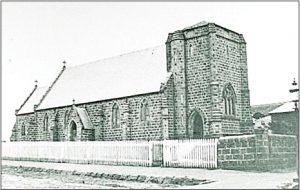
The construction All Saint Church commenced in 1857 and was completed in 1862. The spire was added some 25 years later.
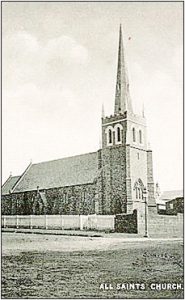
All Saints Church Portland, with its spire. The steel spire was added to the church in 1887.
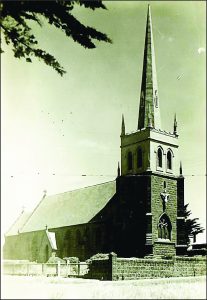
During the twentieth century All Saints Church regularly featured on picture postcards including this Rose Stereographic Company card from the 1950s.



